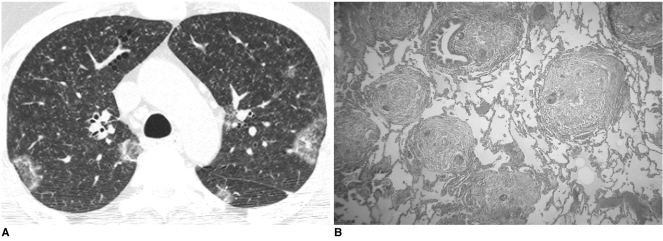We read with great interest the well-written and informative pictorial essay by Park et al. (1), which reviews the thoracic manifestations of sarcoidosis, classifying them as typical and atypical. They indicate that the less frequent and unusual manifestations may be observed in 25% to 30% of cases, emphasizing the difficulty to differentiate sarcoidosis from other diseases, and the importance of understanding the radiological manifestations of sarcoidosis in making a proper diagnosis. We would like to add another atypical aspect of the disease, recently reported by Kumazoe et al. (2) and also observed by us, which is the reversed halo sign (RHS).
The RHS is defined as a focal, rounded area of ground-glass surrounded by an approximately complete ring of consolidation. This sign was described by Kim et al. (3) as a finding that was relatively specific to making a diagnosis for cryptogenic organizing pneumonia (COP). Later, various authors demonstrated the presence of this sign in a wide spectrum of diseases (4), including infectious (paracoccidioidomycosis, tuberculosis, zygomycosis, and aspergillosis, among others) and non-infectious conditions (Wegener's granulomatosis, lymphomatoid granulomatosis, and bronchioloalveolar carcinoma, among other processes). Therefore, the RHS must be regarded as a non-specific sign that is encountered in various pulmonary diseases. Also, it may correspond to secondary organizing pneumonia in numerous conditions, as a response to the primary disease.
In the case reported by Kumazoe et al. (2), the high resolution CT (HRCT) images showed multiple central ground-glass opacities surrounded by crescent or ring-shaped areas of consolidation in both lungs (RHS). Moreover, the authors observed miliary nodules in the central ground-glass opacities and around the outer areas of consolidation. A histopathologic examination revealed noncaseating granulomas and no evidence of organizing pneumonia.
Our patient is a 44-year-old woman that presented with dry cough and mild dyspnea. A physical examination was normal, except for mild bilateral end-inspiratory crackles. The laboratory tests were normal and the HRCT demonstrated small nodules scattered throughout both lungs and focal rounded areas of ground-glass opacity surrounded by rings of consolidation, corresponding to the RHS (Fig. 1). The patient also had bilateral hilar and mediastinal lymphadenopathy. An open lung biopsy showed noncaseating epithelioid cell granulomas, which was compatible with sarcoidosis.
Fig. 1.
Sarcoidosis showing reversed halo sign in 44-year-old woman.
A. High-resolution CT scan demonstrates bilateral localized round and oval areas containing central ground-glass opacities surrounded by crescent or ring-shaped areas of consolidation. Also noted are small nodules scattered throughout both lungs.
B. Photomicrograph of histopathological specimen shows scattered, well demarcated, non-necrotizing granulomas (Hematoxylin & Eosin staining; 40× magnification).
The mechanism of development of the reversed halo sign in pulmonary sarcoidosis is still unclear. Kumazoe et al. (2) assumed that the reversed halo sign in pulmonary sarcoidosis may consist of secondary organizing pneumonia and/or noncaseating granulomatous inflammation. In the case described by Kumazoe et al. (2), as well as in ours, there were small nodules associated with the lesions characterized as reversed halos. We believe that this is an important finding, and thus the presence of small nodules may indicate granulomatous disease, and not organizing pneumonia.
References
- 1.Park HJ, Jung JI, Chung MH, Song SW, Kim HL, Baik JH, et al. Typical and atypical manifestations of intrathoracic sarcoidosis. Korean J Radiol. 2009;10:623–631. doi: 10.3348/kjr.2009.10.6.623. [DOI] [PMC free article] [PubMed] [Google Scholar]
- 2.Kumazoe H, Matsunaga K, Nagata N, Komori M, Wakamatsu K, Kajiki A, et al. "Reversed halo sign" of high-resolution computed tomography in pulmonary sarcoidosis. J Thorac Imaging. 2009;24:66–68. doi: 10.1097/RTI.0b013e318190476f. [DOI] [PubMed] [Google Scholar]
- 3.Kim SJ, Lee KS, Ryu YH, Yoon YC, Choe KO, Kim TS, et al. Reversed halo sign on high-resolution CT of cryptogenic organizing pneumonia: diagnostic implications. AJR Am J Roentgenol. 2003;180:1251–1254. doi: 10.2214/ajr.180.5.1801251. [DOI] [PubMed] [Google Scholar]
- 4.Gasparetto EL, Escuissato DL, Davaus T, de Cerqueira EM, Souza AS, Jr, Marchiori E, et al. Reversed halo sign in pulmonary paracoccidioidomycosis. AJR Am J Roentgenol. 2005;184:1932–1934. doi: 10.2214/ajr.184.6.01841932. [DOI] [PubMed] [Google Scholar]



